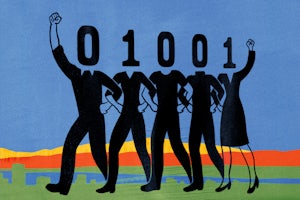In September 2017, Google began work on Project Maven, a Pentagon program that provides artificial intelligence software for drone warfare. More than ten employees were tasked with building a highly realistic surveillance system, like Google Earth, that would render whole cities and buildings, classifying cars as cars and people as people, and allowing the Pentagon to pinpoint both with near precision, in real time, from the skies. Less than a year in, some of the engineers started developing doubts about the project. By February, questions were circulating on Google’s internal communications channels, and soon almost 4,000 employees had signed a petition calling on the company to cancel the contract. “Google,” they wrote, “should not be in the business of war.” In May, a dozen resigned. “It’s one thing for the military to have its own engineers,” a Google employee told me. “It’s another thing for the private sector to build this technology and profit off death.”
Google, of course, is far from the only tech company to take on military contracts. Apple is currently one of a consortium of companies and universities developing “stretchable” electronic sensors to monitor troops and ships; Amazon provides servers, storage, databases, software, and analytics to the CIA through the cloud; Dell licenses software to ICE.
The companies tend to describe such work in overtly patriotic language. In October, Microsoft’s president, Brad Smith, wrote, “We believe in the strong defense of the United States and we want the people who defend it to have access to the nation’s best technology, including from Microsoft.” Jeff Bezos had said much the same only a few days before: “This is a great country, and it does need to be defended.” He was facing dissent at his own company over Rekognition, Amazon’s facial recognition software. Yet as organizers have pointed out, the technology, which can identify and track “persons of interest” in crowded events, is less likely to be used to “defend” the United States than to track down people who themselves need defending. This summer, Amazon was pitching the program to ICE officials, raising concerns that it might be used to target undocumented immigrants.
The tech industry’s relationship with the military dates to the earliest days of computers. In World War II, the United States used IBM’s punch card technology to process detainees in Japanese internment camps. (The Nazis used it, too—something organizers have been keen to mention.) During the Cold War, the United States used Fairchild Semiconductor’s chips in ballistic missiles. ARPA—the Pentagon’s advanced research agency—funded the early internet’s development in the 1960s. Half a century later, its research has made Siri possible, and provided the interface for most Windows laptops. In certain cases, the links between tech and the Pentagon are quite personal. As Leslie Berlin recounts in her book Troublemakers, Steve Jobs saw as mentors some of the early semiconducting pioneers, who had worked with the government during the Cold War. Bezos’s grandfather worked for ARPA.
The long-running intimacy between tech and the Defense Department has not gone unchallenged. In the 1970s, for example, Computer People for Peace protested the Vietnam War from within Silicon Valley, targeting Honeywell Aerospace for manufacturing fragmentation bombs augmented to kill humans, and IBM for what the activists called “corporate racism.” (The company was trying to expand its business into apartheid South Africa.) But Computer People for Peace only ever had a few hundred members. It is hard not to feel that tech’s complicity with the military is too deep to be undone, the ties too strong to be broken. And it’s difficult to predict the prospects of this nascent opposition. Some of the movement’s energy may result from having an antagonist in the White House. “When you’re watching the news and seeing family separation at the border and realize your company works with ICE, that doesn’t feel good,” one woman, who used to organize the tech sector, told me. If a Democratic president takes office, or these images go away, it seems at least conceivable that the walkouts, protests, and petitions will disappear, too.
But at least one organizer I spoke to (on condition of anonymity) did not think so. “If Trump got impeached tomorrow,” the Google employee told me, “we’re not going anywhere.” His efforts would outlast Trump, he believed, because Trump was not their sole object. A Democratic president will also use technology to wage war on other nations and police our own. As the Google worker cast it, the opposition is to state violence broadly conceived, not merely a particular defense contract at a particular company. Some of the efforts aren’t even focused on American policies; Google employees have, for instance, objected to Chinese censorship.
More likely than the possibility of losing momentum after Trump is gone is the possibility that some of the first organizers will leave their companies for different ventures. At Google, some have already resigned in protest, and more could follow; in Silicon Valley, engineers change jobs frequently. A strong union might once have funneled new leaders in behind the first generation, but the organizing against state-sponsored violence has happened on its own. Still, strong internal networks are forming within these companies, along with groups like Tech Workers Coalition, Tech Action, and Tech Solidarity, which are springing up across the country to call protests, hold meetings, and build up a leadership pipeline. These groups offer the beginnings of a kind of infrastructure that unions provide in other industries. Should momentum continue to build, they might even be in a position to organize a strike. In an industry where talent is scarce, strikes could cripple operations.
Company executives will never voluntarily forgo profits. Even as Google was conceding on Project Maven, praising its employees publicly for working to “create a better workplace,” in private the company was urging the government to narrow legal protections for workers’ organizing. If Google gets its way, it could legally punish anyone who used company email to organize protests, circulate petitions, or form a union. (Google told Bloomberg in January that the limitations were floated as just one possible strategy in a legal brief filed to the National Labor Relations Board.) Even so, what organizers have already been able to achieve is significant, and the tech industry as a whole is so powerful that its choices reverberate loudly. A strong internal revolt may lead, eventually, to policy changes on questions of war and surveillance. A few years from now, engineers may be organizing with those who work the supply lines, from warehouses to the cobalt mines of the Global South, and with those directly touched by the implacable force of the state.


